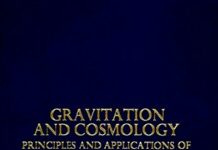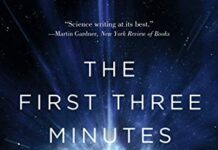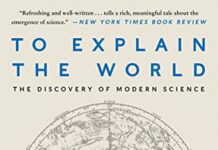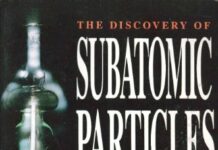
Ebook Info
- Published: 2005
- Number of pages: 638 pages
- Format: PDF
- File Size: 27.69 MB
- Authors: Steven Weinberg
Description
Available for the first time in paperback, The Quantum Theory of Fields is a self-contained, comprehensive, and up-to-date introduction to quantum field theory from Nobel Laureate Steven Weinberg. Volume I introduces the foundations of quantum field theory. The development is fresh and logical throughout, with each step carefully motivated by what has gone before. After a brief historical outline, the book begins with the principles of relativity and quantum mechanics, and the properties of particles that follow. Quantum field theory emerges from this as a natural consequence. The classic calculations of quantum electrodynamics are presented in a thoroughly modern way, showing the use of path integrals and dimensional regularization. It contains much original material, and is peppered with examples and insights drawn from the author’s experience as a leader of elementary particle research. Exercises are included at the end of each chapter.
User’s Reviews
Reviews from Amazon users which were colected at the time this book was published on the website:
⭐I perused my library’s copy of this book when I first began to study QTF. At that early point, I found Weinberg’s detailed exposition to be overwhelming. Now, after reading half of Ryder’s
⭐, a quarter of Peskin and Schroeder’s
⭐, and half of Zee’s
⭐, I have bought my own copy of Weinberg and I have dived in head first. After taking a few weeks to orient myself, I now find myself entranced by Weinberg’s discussion. I have genuine difficulty putting this book down!Weinberg provides an informative first chapter on the history of QTF. The second chapter on relativistic quantum theory goes well with Ryder’s discussion of this topic. Chapter three is on S-matrix scattering theory. I also enjoyed Weinberg’s use of the Cluster Decomposition Principle in Chapter 4 as a lead in and physical motivation for his lucid discussion of Feynman diagrams in Chapter 6.Chapter 5 deserves special mention for its a comprehensive discussion of the Spin Statistics Theorem which deals with both Fermions and Bosons in one fell swoop. The reader needs some help, however, in order to follow Weinberg’s comprehensive treatment of this topic. Some useful insight can be gleaned from the pdf file of the lecture posted online by Bolvan of the University of Texas on the Spin Statistics Theorem. Essentially Weinberg is seen to express the commutators or anticommutators of fields phi(x) and phi(y) in terms of spin sums. Much insight into spin sums for spins larger than 1/2 can be extracted from Weinberg’s paper Phys. Rev. 133, B1318 (1964) that is part of reference 1 cited in Chapter 5.In an Appendix of Weinberg’s 1964 paper one learns that identities for hyperbolic functions are useful in determining the spin sums for different values of spin (e.g 1/2,1,3/2,etc.). Using these identities, the expression exp(-2tp.J)=cosh(2tp.J)-sinh(2tp.J) {where p is a unit vector parallel to the three momentum and J is angular momentum} can be expressed in terms of 3-momentum P and energy E (with P/m=sinh(t); E/m=cosh(t), where m is the particle mass). Before reading Weinberg’s treatment, I was only familiar with spin sums for spin 1/2 Fermions (see for example Peskin and Schroeder pp.48-49).In spite of reading Weinberg’s papers on the Spin Statistics Theorem, however, I felt that I was still missing a great deal of the insight needed to properly understand this important concept. Although Weinberg provides a sufficiently detailed discussion of the symmetries inherent in a massive particle, including the little group that corresponds to those symmetries, his treatment of massless particles left me confused. Luckily I found a more detailed discussion of the symmetries of massless particles in the work of Y.S. Kim and coworkers. In addition to many journal articles on the subject, including many co-authored with Wigner himself, Kim and his colleague M.E. Noz have written two books which treat this topic:
⭐;
⭐. I have read the latter of these two books and have found it be extremely helpful!I should also note that there is a potential difficulty and source of confusion (as one other reviewer has already mentioned) due to Weinberg’s choice of metric. Instead of g00=1; g11=g22=g33=-1, Weinberg goes with g00=-1; g11=g22=g33=1. Also, rather than describing a point in space-time as (t,x,y,z) like in most other QFT books, Weinberg orders the space-time coordinates as (x,y,z,t). Weinberg’s conventions change the appearance of many of the equations, space-time matrices, and four vectors. As a result the Lorentz transformation matrices now look quite different. The dot product of the four vectors p and x changes sign using Weinberg’s conventions, so that what would be exp(-p.r) in Ryder or Peskin and Schroeder becomes exp(+p.r) in Weinberg. Although I will eventually get used to Weinberg’s conventions, I felt that I should post these observations as an alert to others who might consider dedicating themselves to the study of Weinberg.
⭐The good: The content…If you are looking for logically airtight arguments, which explains pretty much every question you could think about in QFT (Why QFT? Is Poincare symmetry and quantum mechanics enough to motivate QFT? … the answer is no), this is it. Weinberg is extremely careful in his arguments, tries to highlight every possible loophole along the way. His approach is to consider the most general case and proceed from there.The cost is it takes quite a while before we get to practical calculations and derivation of the feynman rules (the first 100 pages or so just work with principles of symmetry and locality of interactions to force QFT as a logical necessity). Not good if you want to quickly solve some homework cross-section scattering problem, but do revisit here after a first QFT course when you have the leisure to try to answer all the why? questions you skipped at first.The bad: The typography & bindingThe typography is absolutely horrible, with expressions that have gazillion roman/latin indices, curly expressions and indices hanging off of indices. For such a classic, I wish someone took the effort to latex it properly and republish it.
⭐This book is only appropriate for those with excellent foundation in advanced quantum mechanics and deep knowledge of mathematical and theoretical physics. Not recommended for beginners since it is a very mathematically rigorous exposition of quantum field theory. However it can be served as an additional reference material for those taking graduate courses in quantum field theory for the first time
⭐I bought this book for myself for a birthday treat, and I was not disappointed. His approach is refreshing and insightful, the treatment is thorough and satisfyingly complete.I wish I had this book when I was learning the subject.. As others have said, this is not for the first year graduate student. But for the serious student who has picked up some the material already, it is a must have.
⭐As usual, professor Weinberg has written a great Quantum Fields text.
⭐Physics is usually a horribly taught subject, that is why most students avoid it. When it is effectively communicated, physics can be wonderful. This book represents the former. It is dense. The author is obviously a brilliant person; but, he is not a brilliant communicator. I’ve got a Master’s in Physics and I was lost by the end of the second chapter. I have no doubt that the mathematics as presented are accurate; however, alone they fail to effectively communicate the substance of the topic to a mere mortal. Weinberg does not spend adequate time discussing the context, reality, or historical evolution of his ideas. I purchased all three volumes and, apparently, waisted my money.I later purchased Roger Penrose’s “The Road to Reality” and thoroughly enjoyed it. It was not an easy read either, but Penrose spent a significant amount of time recounting historical context, impact, and the ‘reality’ of his ideas.
⭐I like the general philosophy behind the book. The author wants to explain why QFT is the way it is.
⭐I ordered this book for a QFT class I was taking, and Weinberg does a very thorough job explaining concepts clearly and succinctly. Many other books lose me by jumping around too much and assuming a lot of extraneous knowledge, but Weinberg makes few assumptions about what the reader already knows.
⭐Very interesting – I enjoyed the mixture of content and historical context
⭐excellent
⭐As others have already said here, Weinberg’s treatment of quantum field theory (QFT) is hardly suitable for beginners. It is also not useful as an accompaniment to any lecture on the subject, unless the lecture is based directly on the book (I sincerely hope no professor would consider using this text for an introductory QFT course). This is because Weinberg insists on using a highly nonstandard notation, apparently trying to appeal to readers with a background in mathematics. Indeed, a lot of technical aspects are presented in a manner that is unusually rigorous in its mathematics, instead cutting down on the type of “intuitive” explanations that most physics texts (and physicists) prefer. At times this book reminded me of Ticciati’s “Quantum Field Theory for Mathematicians”, an interesting book in its own right. However, whereas Ticciati’s logic can be easily followed, Weinberg apparently does not realize that most of his “trivial” statements are left unexplained, and are in fact incomprehensible without knowledge from other books.For whom is this book suited, then? If you already have a strong background in quantum field theory and a feel for mathematical thinking, and missed technical rigorosity in Peskin & Schroeder’s 800-page tome, you might want to give this book a try. If you want to actually understand quantum field theory or particle physics, you’ll be better off with Zee’s “QFT in a nutshell” or Peskin/Schroeder as an introduction and Cheng/Li for more advanced topics. I think the vast majority of potential readers belongs to the second group.
⭐The trilogy of books on QFT by Weinberg is a necessary reference for everyone studying and working in this field. Although it might not contain as many practical examples as in other references ( Peskin’s and Schwart’s books are the best for applications), this volume explains the subject with a level of detail which is hard to find elsewhere.As in any other Weinberg’s books the notation is a bit cumbersome, but nonetheless the author’s explanations are worth the price.
⭐Das Buch ist auf englisch geschrieben.Ich empfehle es jedem, der Quantenfeldtheorie (QFT) lernen möchte. Das Buch ist sehr dick und man versteht die Quantenfeldtheorie erst, wenn man das Buch einmal komplett durchgelesen hat. Das dauert – natürlich je nach Studienverhalten – länger als ein Semester. Von einer kürzeren Lektüre rate ich ab. Entweder will man QFT verstehen, dann empfehle ich dieses Buch. Oder mann will QFT nicht verstehen, dann sollte man gar kein Buch lesen.
Keywords
Free Download The Quantum Theory of Fields: Volume 1, Foundations in PDF format
The Quantum Theory of Fields: Volume 1, Foundations PDF Free Download
Download The Quantum Theory of Fields: Volume 1, Foundations 2005 PDF Free
The Quantum Theory of Fields: Volume 1, Foundations 2005 PDF Free Download
Download The Quantum Theory of Fields: Volume 1, Foundations PDF
Free Download Ebook The Quantum Theory of Fields: Volume 1, Foundations




